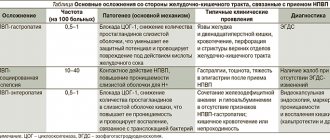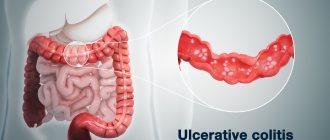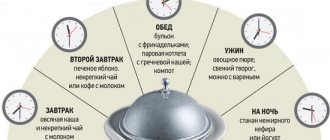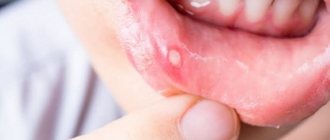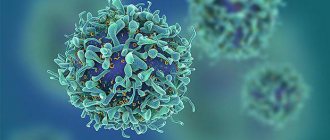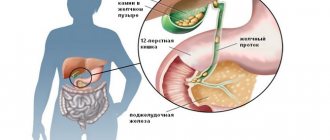Like other diseases caused by a non-pathogenic agent, non-infectious gastroenteritis and unspecified colitis often occur as a result of poor diet, overeating, and also in case of non-compliance with personal hygiene rules.
Gastroenteritis is a disease in which the mucous membranes of the stomach and small intestine become inflamed; when the inflammatory process spreads, the large intestine also joins the pathological process (colitis).
The pathology is revealed by abdominal pain, nausea, vomiting, and diarrhea. The disease can also be manifested by fever, muscle pain and general weakness.
General information
Gastroenterocolitis is an inflammatory lesion of the stomach, large and small intestines. The disease can be acute or chronic. Acute gastroenterocolitis responds well to treatment if the true source of the pathology is quickly identified and eliminated. In chronic cases, special attention is paid to lifestyle correction and diet. Acute gastroenterocolitis in severe cases requires a 24-hour hospital stay, mild forms are treated on an outpatient basis. The code for gastroenterocolitis according to ICD-10 is K52.
What it is
Chronic gastroenteritis, caused as a result of an unhealthy lifestyle when a person abuses alcoholic beverages, is constantly exposed to the harmful effects of aggressive chemicals, and also caused by a tendency to allergies or infection with a parasitic disease, is non-infectious. The transition to the acute form of gastroenteritis is associated with a prolonged influence of negative factors on the stomach and small intestine; in some cases, the inflammatory process spreads, affecting the large intestine, causing dystrophic changes in its mucous membrane.
Non-infectious gastroenteritis and unspecified colitis is a rather serious pathological process, since it affects the entire digestive tract, the level of stomach acidity, the absorption activity of the intestinal walls and the complete digestion of food taken. Signs of gastroenteritis include heartburn, belching, and bloating.
Pathogenesis
In infectious gastroenterocolitis, the pathogenesis is determined by the pathogen. In all cases, the pathogenic agent enters the body through the nutritional route , through the mouth. Next, microorganisms multiply and die in the intestines with the release of endo- and exotoxins. Intoxication of the body develops as a result of the negative effects of toxins on the mucous membrane of the digestive tract.
Types of toxins:
- neurogenic toxins ( Dysentery , Botulism );
- toxins that change the structure of intestinal epithelial cells ( Cholera );
- toxins that cause necrosis ( Amebiasis ).
With salmonellosis, the pathogenic agent first penetrates the mucous membrane of the digestive tract, and from there it is transported into the bloodstream.
The basis of alimentary gastroenterocolitis is acute indigestion due to an unbalanced and irrational diet. The alimentary form is most often found in patients suffering from functional disorders of various parts of the digestive chain:
- insufficient secretory capacity of the stomach;
- defects in the masticatory apparatus;
- intestinal dyskinesia;
- violation of bile drainage ;
- violation of the secretory ability of the pancreas.
Gastroenteritis can also be triggered by allergic responses to certain foods.
Non-infectious gastroenterocolitis is characterized by the presence of foci of inflammation in the tissues of the stomach and intestines in the form of:
- swelling of the mucous membrane;
- increased cellular infiltration;
- excessive exudation;
- hyperemia;
- dystrophic changes in the surface epithelium.
Changes in the digestive tract can be generalized or localized.
Diagnostics
- Diagnosis of inflammation of the mucous membranes of the stomach, small and large intestines is carried out by interviewing the patient. The doctor finds out the patient’s symptoms, lists the foods he ate, and collects anamnesis.
- Afterwards, laboratory and instrumental tests are prescribed.
- Blood, urine and stool tests are prescribed to confirm the absence (presence of infection) in the body. If necessary, the doctor prescribes a culture of feces and vomit.
- An esophagogastroduodenoscopy is performed, which allows one to assess the condition of the stomach and the initial parts of the small intestine.
- An ultrasound of the abdominal organs is prescribed, and if necessary, MRI and CT.
- To determine the degree of inflammation of the colon, retoromanoscopy is additionally prescribed.
Classification
There are several forms depending on the nature of changes in the tissues of the stomach and intestines:
- Catarrhal form . The inflammatory process is limited by hyperemia, slight swelling of the mucous membranes together with intense production of exudate.
- Fibrous form . As a result of the interaction of fibrinogen and tissue thromboplastin, fibrin is formed, which settles in the form of plaque on the inner surface of the intestines and stomach.
- Phlegmonous form . The mucous membranes of the digestive tract become inflamed to the point of suppuration.
- Ulcerative form . Ulcerations gradually form on the mucous membranes.
- Hemorrhagic form . As a result of a pronounced inflammatory process, capillary blood circulation in the submucosa is disrupted, which leads to the formation of extensive erosive foci.
What does it look like
If necessary, the doctor prescribes endoscopic examinations to the patient in order to visualize the pathological process in the upper gastrointestinal tract, during which, with non-infectious gastroenteritis and unspecified colitis, degenerative changes in the large intestine, swelling and redness of the mucous membrane of the large intestine and gastric mucosa may be observed. All changes are nonspecific, reversible and completely disappear after properly organized medical therapy.
Causes
Diarrheal syndrome and dyspeptic disorders in gastroenterocolitis are caused by damage to the villi of the intestinal ciliated epithelium, which are responsible for the absorption of water and nutrients.
Infectious gastroenterocolitis is characterized by intoxication of the body with specific waste products of microbes. Acute forms develop against the background of food toxic infections . The causative agents are conditionally pathogenic and enteropathogenic microorganisms:
- Shigella;
- salmonella;
- proteus vulgaris;
- coli;
- listeria.
Gastroenterocolitis can also be caused by viruses:
- Norwalk virus;
- rotavirus;
- echovirus , etc.
Infection occurs through the nutritional route: through the consumption of low-quality products, unboiled water, and failure to comply with the rules of sanitary and hygienic standards and personal hygiene.
If the patient has foci of chronic infection and sepsis, infection can occur through the hematogenous route: pathogenic pathogens enter the digestive tract from other organs and systems through the circulatory system. Non-infectious gastroenterocolitis is associated with drug and food allergies, poisoning with alcohols, salts of heavy metals, acids, alkalis, or after radiation injury.
Chronic gastroenterocolitis develops against the background of primary diseases of the digestive tract or as a result of a protracted acute process. Inflammation affects blood vessels, submucosal layer, serous membranes, nerve endings, which negatively affects trophism, blood supply and motility of the digestive tract.
The risk of developing gastroenterocolitis is increased in conditions accompanied by increased permeability of the mucous membranes and suppression of local immunity:
- anemia;
- deficiency B vitamins
- prolonged stress;
- frequent cold drinks;
- irritation of the intestinal walls due to excessive consumption of coarse fiber foods;
- Achilles.
Prevention
To prevent non-infectious gastroenteritis, it is necessary to maintain personal hygiene and eat only washed fruits and vegetables. You need to prepare food with clean hands, in clean dishes from high-quality and fresh ingredients. You should avoid eating unfamiliar foods, unknown types of mushrooms, and expired food.
You need to give up bad habits and include more fresh vegetables and fruits in your diet.
Timely treatment of pathologies of the digestive system and care for dental health are important.
Symptoms of gastroenterocolitis
The incubation period for infectious gastroenterocolitis is very short, so the first symptoms do not take long to appear and appear within a few hours after poisoning. Symptoms of gastroenterocolitis in adults:
- Excessive bloating, severe flatulence , accompanied by loud rumbling; lack of interest in food and appetite.
- Diarrheal syndrome. Loose stools appear on the 3-4th day of illness. There may be mucus and streaks of blood in the stool.
- Severe pain in the umbilical region. The pain is nagging, cramping in nature.
- Headaches , severe weakness, increased body temperature, dizziness . In severe cases, there may be fainting and loss of consciousness.
- Dyspeptic disorders in the form of belching , heartburn , feelings of bitterness in the mouth.
- Constipation for 1-2 days followed by diarrhea.
- Repeated vomiting of undigested food leftovers.
- Sharp weight loss.
In some cases, gastroenterocolitis resolves without dyspeptic disorders due to general intoxication of the body.
Gradually, the inflammatory process spreads to neighboring organs that take an active part in the digestive process.
Acute gastroenterocolitis begins with lightning speed, unexpectedly. The specific clinical picture develops very quickly. The disease debuts with repeated vomiting, a constant feeling of nausea, and severe diarrhea syndrome. Severe poisoning of the body is indicated by chills , sweating , a sharp increase in body temperature, and severe weakness. The symptoms described above may appear in the first hours, immediately after damage to the digestive tract, or maybe after 2-3 days.
With timely treatment, the acute phase of gastroenterocolitis passes very quickly and without consequences. In advanced cases, in the absence of adequate therapy, the disease takes on a chronic, relapsing form.
Symptoms in adults
Non-infectious gastroenteritis can manifest itself in acute and chronic forms. The acute form of the disease can be of different types:
- Toxic. It appears as a result of poisoning of the body with chemicals or low-quality products, when eating thermally incorrectly processed food, when toxins enter the stomach.
- Nutritional disorder. The causes of this type of disorder are unbalanced diet, consumption of fatty, spicy foods, alcohol abuse, and smoking.
- Eosinophilic or allergic. It occurs as a response of the body to medications, chemicals or certain products to which the patient may have an individual intolerance.
In adult patients, sometimes an allergic reaction to certain products or substances develops in childhood. Predisposition to acute non-infectious gastroenteritis can manifest itself if the rules of breastfeeding or diet are violated in early infancy.
Symptoms in the acute form of the disease depend on the severity of the pathology. There are mild, medium and severe forms. The clinical picture is more pronounced in severe cases of the disease, when mucus and blood clots appear in the stool.
Symptoms of the disease also include:
- Nausea and vomiting, which are the body’s defense mechanisms when there is a need to get rid of toxic substances;
- Diarrhea. Basically, with the first stool, all unnecessary elements come out, along with water and useful, but not yet absorbed, substances. The phenomenon is dangerous because it can cause dehydration;
- Painful sensations that increase with palpation. Pain is localized in the navel area, in the epigastric area;
- Cold sweat, general weakness;
- A rash on the face, pimples, which indicate inflammatory processes in the intestines.
The chronic form of the disease occurs with constant changes in periods of remission. This form has a distinctive clinical picture and initial symptoms.
Chronic gastroenteritis of a non-infectious nature is revealed by lethargy, a constant feeling of fatigue, and irritability. Painful sensations occur from time to time. Frequent urge to go to the toilet is also characteristic of the disease. In severe cases, the patient may go to the toilet about 15 times or more. Increased flatulence, rumbling, and loss of appetite are observed.
Symptoms also include bloating as a result of flatulence, muscle pain and headache.
Symptoms of gastroenterocolitis in children
The disease in children begins with a sharp rise in temperature to 38-40 degrees, the child is constantly bothered by vomiting and the urge to vomit. A small patient may complain of pain in the epigastric region, and when examining stool by an adult, blood may be detected. Feces may take on a greenish tint due to oxidative processes present. A child with the symptoms described above must be hospitalized in a 24-hour hospital due to the risk of dehydration and the development of other unpleasant complications.
Contraindications
For non-infectious gastroenteritis and unspecified colitis, the independent use of sorbents and antibiotic drugs is not recommended. The choice of medication should be made by the doctor based on the general condition of the patient.
If the disease is caused by poisoning with aggressive chemicals or other toxic elements, gastric lavage at home is not allowed. Vomit containing these harmful substances, when released back, can cause burns and aggravate the patient's condition. Gastric lavage should be done in a hospital setting using a tube.
Do not feed the patient until the urge to vomit stops. Paracetamol can be given if there are no liver diseases.
During the treatment course, sports are contraindicated. Excessive physical activity is not allowed.
Tests and diagnostics
Diagnosis of the disease is based on objective examination data, test results, laboratory tests and clinical symptoms.
Laboratory tests performed will include:
- feces;
- blood;
- vomit;
- other biological fluids.
If a viral etiology of the disease is suspected, a special virological study is performed based on the polymerase chain reaction method. An agglutination method and enzyme immunoassay are also performed. In parallel, methods that diagnose allergic responses in the body can be used. Most often, prick screening and determination of the level of immunoglobulin E .
Toxicological research methods are also carried out, with the help of which both the patient’s biological fluids and food products are examined. The examination allows you to identify exo- and endotoxins of viral and bacterial etiology, as well as food toxins.
Serological tests allow you to determine the titer of antigens and titres of antibodies . The severity of the disease and quantitative assessment of the content of microorganisms are obtained based on the results of antigen levels. The causative agent of gastroenterocolitis and the degree of contamination can be determined as accurately as possible based on the results of a bacteriological study. The data obtained allows us to select the appropriate treatment.
Instrumental diagnostics
Instrumental examination methods for gastroenterocolitis include:
- colonoscopy;
- sigmoidoscopy;
- irrigoscopy.
The methods described above make it possible to diagnose changes in internal organs and assess the severity of abnormal phenomena in the rectum and sigmoid colon, which are often found in gastroenterocolitis.
Additionally, an ultrasound examination is prescribed, which clearly demonstrates the size, shape and localization of the pathological process.
In certain cases, a biopsy - the removal of part of the tissue of an internal organ. Most often, the mucous membrane of the stomach, intestines and microvilli are examined. A biopsy is taken during an endoscopic examination.
Differential diagnosis
The clinical picture of gastroenterocolitis is similar to other diseases of the digestive tract, which makes diagnosis difficult. Quite often, gastroenterocolitis is only a complication or consequence of another disease.
First of all, differential diagnosis is carried out with colitis and enteritis , because These diseases have a similar symptom complex. The main difference between enteritis is the presence of diffuse catarrhal phenomena, which occur mainly in the proximal part of the intestine. Pinpoint hemorrhages are also typical.
With colitis, a pronounced inflammatory process is observed (fibrinous or catarrhal form). Colitis is characterized by ulcerative lesions, erosions and hemorrhages.
Diagnosis of gastroenteritis
The clinical picture of many types of gastroenteritis is very clear. And to make a diagnosis, it is often enough for a doctor to ask the patient about complaints and conduct a general examination. When palpating the abdomen, swollen intestinal loops are detected. The doctor may also listen to your bowel movements. It is usually very active, accompanied by many sounds.
The most important thing is to establish the cause of the disease, as this determines the treatment plan. Therefore, in some cases, the doctor prescribes additional tests. For many infectious diseases, tests have been developed that can identify the pathogen; parasites and bacteria are detected by microscopy or stool culture.
A general and biochemical blood test is prescribed for patients with a severe form of the disease, since in these cases the functioning of internal organs is disrupted (for example, the kidneys suffer from gastroenteritis caused by E. coli).
Treatment of gastroenterocolitis
Therapy depends on the causative agent of the disease, the form and nature of the pathology. In mild forms of gastroenterocolitis, hospitalization in a 24-hour hospital is not required. In severe cases, the patient is sent to the infectious diseases department for step-by-step therapy.
Treatment of gastroenterocolitis in adults takes place in several stages:
- Rehydration . Acute gastroeterocolitis begins with increased removal of fluid from the body. A set of therapeutic measures is aimed at eliminating dehydration and the associated consequences for the body. The patient is injected with salts and other compounds, which are rapidly eliminated from the body. For mild cases of the disease, it is sufficient to administer Oralit , Regidron and other complex medicinal solutions. In more advanced cases, Trisol , Disol , Chlosol .
- Antibacterial treatment . Antimicrobial therapy is used only in extreme cases with a prolonged inflammatory process. The most commonly used are Levomycetin , Erythromycin , Ampicillin .
- Detoxification therapy . Detoxification therapy is aimed at enhanced removal of toxins from the patient’s blood. The most effective is gastric lavage, which allows you to remove toxins, undigested food and salt from the digestive tract. During flushing, not only toxins are removed, but also pathogenic microorganisms. The best effect is achieved by adding potassium or sodium permanganate to water.
- Syndromic treatment . In case of constipation, laxatives are prescribed, in case of pain - painkillers, in case of spasms - antispasmodic medications, in case of poor digestion of food - enzymes and agents that improve motility and peristalsis of the gastrointestinal tract.
Additionally, vitamin therapy is recommended. Prebiotics and probiotics to restore intestinal microflora . If an allergic response develops, taking antihistamines is indicated.
Treatment of gastroenterocolitis in children
There are a number of features regarding the course of the disease and treatment. Gastroenterocolitis in children is more complicated, which is explained by very rapid dehydration compared to adults. Acute gastroenterocolitis requires immediate fluid replacement. Not all drugs prescribed for adults can be used in pediatric practice. Gastric lavage in a child is carried out only if there is a risk of absorption of bacterial toxins.
Treatment of gastroenteritis
Therapy for gastroenteritis works in two directions:
- eliminates the root cause, if possible;
- corrects symptoms and consequences.
There is no specific treatment for viral gastroenteritis. For mild symptoms, rest and drinking plenty of fluids is all that is needed for a successful recovery. Severe dehydration, lack of fluid and certain electrolytes are corrected by administering intravenous solutions.
Bacterial gastroenteritis requires treatment with antibiotics, parasitic gastroenteritis with anthelmintic drugs. If you suspect you have a food intolerance, the most important thing to do is to eliminate foods that may cause the condition from your diet. If gastroenteritis develops as a side effect of medications, the doctor may try to replace the drugs in the current regimen with analogues. In cases where inflammation is only a symptom, the way to get rid of it is to treat the underlying disease.
Drinking plenty of fluids is always necessary, and antipyretics are prescribed for fever. Antidiarrheals such as Imodium are not always welcome.
They are prescribed only to children over two years of age with watery diarrhea, and only after checking the stool for occult blood.
Children, as well as other people at risk, are recommended to drink rehydration drinks if they have diarrhea and vomiting.
Procedures and operations
An important component of the complex treatment of gastroenterocolitis is physiotherapeutic treatment. Procedures are not prescribed in the acute stage of the disease. The following have a positive effect on gastroenterocolitis in adults:
- acupuncture;
- visceral abdominal massage;
- electrophoresis with drugs;
- reflexology.
Gastroenterocolitis is treated mainly with medication. It is extremely rare to resort to surgical treatment. In some cases, part of the stomach or part of the intestines is removed. Such radical operations are resorted to only in advanced gastroenterocolitis. Indications for surgical treatment:
- ulcerative lesions of the digestive tract;
- bleeding of the mucous membranes of the gastrointestinal tract.
Also, surgical treatment is resorted to when the infectious process spreads and necrosis . Timely surgical care helps prevent sepsis and bacteremia .
Clinical guidelines
Non-infectious gastroenteritis is an inflammatory-dystorphic disease that involves the stomach, small and large intestines.
Non-infectious gastroenteritis is characterized by infiltration predominantly by eosinophils of the lamina propria of the mucous membrane of the antral zone of the stomach, epithelium, pitted glands with the formation of eosinophilic abscesses. The pathology is characterized by damage to the small and large intestines, the esophagus, as well as individual allergic reactions to specific products and substances.
The criterion for diagnosis is symptoms characteristic of the inflammatory process of the organs of the gastrointestinal tract. Specific features include tenesmus, cramping pain in the abdomen that does not disappear after bowel movements, rumbling in the abdomen, and if the colon is involved - constipation, stool in the form of sheep feces.
With palpation of the abdomen and strong pressure, pain is recorded in the umbilical area. Rumbling and pain are recorded upon palpation of the cecum (exemplary symptom). The patient may experience an enlarged liver and increased flatulence.
Diagnosis is carried out as for acute gastroenteritis (the list of examinations corresponds to examinations for gastrointestinal pathologies, colitis, enteritis); differential diagnosis is also required.
It is recommended to carry out anti-inflammatory therapy and use drugs to eliminate pain and normalize intestinal motor function.
If necessary, selective decoptation of conditionally pathogenic flora and correction of microbiocenosis disorders is carried out, and a diet is prescribed.
Drug therapy includes:
- Derivatives 8 – hydroxyquinoline, quinol group;
- Nitroimidazoles;
- Proton pump inhibitors;
- Antispasmodics;
- Prokinetics;
- Hormonal drugs.
A course of physiotherapy is prescribed, preventive measures are recommended, such as timely treatment of gastrointestinal diseases, adherence to a rational diet, and regular sanitation of the oral cavity.
Treatment of gastroenterocolitis with folk remedies
In addition to traditional treatment, herbal medicine has a positive effect on the course of the inflammatory process.
- Perga . Known for its healing properties against foodborne illnesses. It is used not only for treatment, but also for preventive purposes. Bee bread is pollen from plants collected by bees. A pronounced effect is observed in the elderly and children. Bee bread has restorative and stimulating properties, promotes regeneration . In elderly people, the use of bee bread slows down the aging process and normalizes the functioning of the endocrine and immune systems.
- Sea buckthorn . Used as enemas. In medicine, not only the oil extracted from the seeds is used, but also the fruits themselves, which can be consumed orally or made into an herbal infusion.
- Juice from seeded carrots . For the treatment of gastroenterocolitis, 100-125 ml of root vegetable juice is prescribed twice a day, on an empty stomach.
Acute colitis
Acute colitis is a pathology of the large intestine, accompanied by the development of an inflammatory process and a violation of the functional state of the organ. Patients aged 15-45 years and elderly people are at risk. The disease occurs with equal frequency in women and men. With proper and timely treatment, the disease can be completely cured and does not cause serious complications.
The lack of adequate treatment can cause the inflammatory process to progress and spread to adjacent organs. Gastroenterologists and proctologists treat OK.
Diet for gastroenterocolitis
Diet for gastroenteritis
- Efficacy: therapeutic effect after 7-14 days
- Terms: 10-60 days
- Cost of products: 1300-1400 rubles per week
An important component of treatment is diet therapy. With the correct diet, the recovery process of a patient with gastroenterocolitis is significantly accelerated. Food products should be light, but at the same time nutritious, capable of providing the body with all the necessary microelements and vitamins. The basis of the diet is fruit and vegetable soups and cereals.
Fatty and fried foods, all smoked foods and pickles, sour fruits, spices and all foods that irritate the intestinal mucosa should be excluded from the nutrition program.
It is recommended to limit the consumption of dairy products, brown bread and fruit compotes. Good results are achieved by split meals (6-7 days a day) in small portions, which ensures gradual movement of the food bolus through the digestive tract and rapid digestion. Gastroenterocolitis is often accompanied by dehydration, so patients are advised to maintain a drinking regime, drinking 2-3 liters of clean water per day.
The above measures allow you to completely restore the functioning of the digestive tract and get rid of the unpleasant symptoms of the disease. With improper and untimely treatment, the pathology becomes chronic, affecting mainly one part of the digestive system. Before starting treatment, it is important to find out the cause of the disease.
Treatment for adults
Non-infectious gastroenteritis and unspecified colitis should be treated taking into account the state of the digestive tract, since with this pathology almost the entire gastrointestinal system is involved in the inflammatory process.
When the cause of the disease is intoxication, gastric lavage is performed immediately, which helps prevent the absorption of toxic substances into the bloodstream.
When the cause of the disease is helminth infestation, an appropriate course of treatment is prescribed.
In the initial phase of the disease, it is recommended to take enterosorbents. Smecta and activated carbon are prescribed. Drinking plenty of fluids is necessary. It is recommended to take medicinal mineral water and a decoction of medicinal plants.
A therapeutic diet is prescribed, which must be followed for 10 days, and for another week after the symptoms disappear.
If necessary, antibiotics are prescribed, the choice of which is made by the doctor based on the degree of the inflammatory process. Enveloping drugs are also prescribed, which help restore damaged mucous membranes of the gastrointestinal tract.
A saline solution is injected inside to prevent intoxication. Vitamin therapy is carried out to strengthen the immune system and replenish the body's deficiency, which appears as a result of frequent vomiting and diarrhea.
Eubiotics are prescribed to normalize the microflora of the digestive tract.
Prognosis and prevention
After 3-6 weeks from the onset of the disease, the acute stage completely subsides and the parietal structures and functions of the digestive tract are completely restored.
Complete recovery from gastroenterocolitis associated with food toxic infection occurs within a week with properly selected diet therapy. However, if the inflammatory process develops against the background of functional intestinal or gastric failure, against the background of helminthic infestations or other pathology of the digestive organs, then the disease can become chronic.
The main prevention consists of a balanced diet, full compliance with the rules of personal hygiene, and compliance with all sanitary and hygienic standards when preparing and storing food.
Prevention of gastroenteritis
The best prevention of infectious gastroenteritis is to follow the basic rules of personal hygiene familiar to everyone:
- wash your hands thoroughly after using the toilet and before eating;
- do not drink raw water, especially from unfamiliar sources and stagnant bodies of water;
- avoid suspicious catering establishments;
- if there is a patient at home, provide him with individual dishes, do not share towels with him;
- disinfect changing and diaper changing areas if the child is sick;
- Travel lovers are advised to find out the local cuisine in advance and avoid potentially dangerous dishes. First of all, this applies to visiting countries where the native cuisine is very different from the usual one, or ingredients that are not thermally processed are used. It is better to buy bottled water.
Proper nutrition and a healthy lifestyle will help prevent chronic gastroenteritis.
Children can be vaccinated against the most common intestinal virus - the causative agent of rotavirus infection. The need for vaccination and details can be obtained from your pediatrician.
Olga Landsman
Types of disease
The classification of gastroenteritis depends on the form of the disease. The form can be acute or chronic. The etiology and pathogenesis of diseases differ.
Acute conditions are divided into several types. One of them is hemorrhagic - characterized by severe vomiting, sometimes with blood. In this case, thickening of the patient’s blood is observed.
Eosinophilic gastroenteritis is a fairly rare type of disease. The main characteristics of the disease are severe vomiting, abdominal pain, diarrhea, loss of appetite. The diagnosis is made on the basis of tests and examinations of the stomach using X-ray equipment, taking a biopsy, and examination with an endoscope during laparoscopy.
Chronic gastroenteritis is divided into several types:
- Infectious. It is considered a very contagious species, in which you can get sick by eating poorly processed meat, fish, unwashed vegetables and fruits. Salmonella gastroenteritis is especially dangerous, in which salmonellosis infection appears in the body, causing an acute condition for the patient.
- Nutritional – non-infectious, caused by various factors in the form of diseases of the digestive system due to poor nutrition, frequent alcohol consumption, the habit of smoking and not following a daily routine.
In addition, viral gastroenteritis is isolated. The most common type of disease that occurs when a virus enters a person’s bloodstream.
Human circulatory system
The bacterial type is characterized by division into several subspecies:
- Rotavirus;
- Adenoviral;
- Coronary;
- Protozoan;
- Norovirus;
- Catarrhal;
- Allergic.
As a result of this type of disease, a person most often faces dehydration - a serious condition that requires hospitalization and medical care.
Toxic is a type of disease that occurs when poisoned by chemicals of various origins, poisonous mushrooms and herbs.
There is hemorrhagic gastroenteritis, which is characterized by an acute onset of the disease with vomiting and diarrhea. But its origin is mainly associated with allergic reactions.
Separately, there is an acute gastroenteritis of an unspecified type, in which the causative agent of the disease remains unknown, it is unclear what affected the inflammation.
Treatment
If you detect symptoms of the disease that do not cause severe discomfort and a threatening condition, you can try using treatment techniques at home:
- Temporary refusal to eat. Fasting for a while will help relieve nausea, vomiting and diarrhea. The gradual introduction of food into the diet should be moderate. To begin with, you should introduce porridge with water, crackers, boiled white fish or chicken. But if, when you start eating, the feeling of nausea or diarrhea returns, you should stop eating for a while longer.
- Until the symptom subsides completely, you should avoid fatty, salty, and spicy foods. Strong teas and coffee, alcohol, and cigarettes are prohibited. Fermented milk products are also prohibited for gastroenteritis.
- It's important to drink a lot. In case of illness, possible dehydration poses a major threat to health. Fluid replacement is a necessary stage of treatment. You can drink both water and broths, special pharmaceutical solutions to replenish the vital forces of the body. If you notice obvious signs of dehydration: extreme thirst, rare urge to urinate, concentrated urine, you should immediately seek help from a doctor.
If a child becomes ill, which often happens in kindergarten, measures similar to the treatment of an adult should be taken. Signs of the disease are often similar to those seen in adults. First of all, it is important to give special solutions with electrolytes to drink. Plain water may be ineffective, since it is not absorbed by the body and is immediately eliminated in the presence of severe and frequent diarrhea. Fermented milk products, juices, including apple juice, are prohibited.
After vomiting in children stops, it is worth offering the child foods that are easily digested by the body and absorbed. Porridge with water - suitable for the first food after illness, stale bread or crackers. Light broth, dry biscuits, boiled rice or potatoes. All sweets are prohibited.
In a children's institution for gastroenteritis, quarantine is introduced for 7-10 days; it is important to provide the child with peace and proper care at home, if the condition allows. If there are signs of dehydration or ineffective actions, you should seek medical help; it is advisable to call an ambulance, since processes in the child’s body proceed faster. The medical history is carefully studied to understand the origin of the disease and the source of infection of the child. Often children experience symptoms of unspecified origin, similar to gastroenteritis.
If you notice symptoms of gastroenteritis during pregnancy, you should not wait and use self-treatment techniques at home, since the health threat is present not only for the mother, but also for the fetus! Pregnant women are prohibited from certain medications that are acceptable in the treatment of gastroenteritis, as they affect the condition of the child. A pregnant woman should be treated under certain conditions. The incubation period lasts about three days.
- Strict diet.
- Mandatory adherence to medical recommendations.
- Drink plenty of fluids.
- IVs for signs of dehydration.
- Purpose of enzymes.
- Antimicrobial drugs.
It is very important to observe the rules of personal hygiene, since the disease is contagious and is transmitted quickly through dirty hands, which is especially dangerous in pregnant women and poses a threat to the development of the fetus.
Treatment for gastroenteritis in adult patients comes down, first of all, to eliminating the uncomfortable symptoms of nausea, vomiting, and diarrhea. At first, the adult patient also fasts and drinks plenty of fluids. After the condition has been restored to normal, it is important not to overload the stomach and intestines, gradually introducing light foods and monitoring the patient’s condition. At first, when you become ill, bed rest and avoidance of physical labor are required.
In mild cases, clinical manifestations are complicated by nausea and diarrhea, without dehydration, so the patient is prescribed a diet, plenty of fluids, enzymes that improve the functioning of the gastrointestinal tract, and antimicrobial agents.
For moderately severe illnesses, an antibiotic is often prescribed to stop the proliferation of bacteria in the body. Medicines are used in the form of droppers; for mild cases, tablets are prescribed. Agents are often used to restore the gastric mucosa and relieve the inflammatory process that affects the small and large intestines, as well as to prevent complications. Such drugs include enterofuril, suitable for adults and children.
